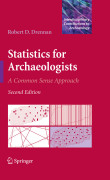
In the decade since its publication, the first edition of Statistics for Archaeologists has become a staple in the classroom. Taking a jargon-free approach, this teaching tool introduces the basic principles of statistics to archaeologists. The author covers the necessary techniques for analyzing data collected in the field and laboratory as well as for evaluating the significance of the relationships between variables. In addition, chapters discuss the special concerns of working with samples. This well-illustrated guide features several practice problems making it an ideal text for students in archaeology and anthropology. Using feedback from students and teachers who have been using the first edition, as well as another ten years of personal experience with the text, the author has provided an updated and revised second edition with a number of important changes. New topics covered include: -Proportions and Densities-Error Ranges for Medians-Resampling Approaches-Residuals from Regression-Point Sampling-Multivariate Analysis-Similarity Measures-Multidimensional Scaling-Principal Components Analysis-Cluster Analysis Those already familiar with the clear and useful format of Statistics for Archaeologists will find this new edition a welcome update, and the new sections will make this seminal textbook anindispensible resource for a whole new group of students, professors, and practitioners. INDICE: Numerical Exploration: 1. Batches of Numbers (Stem-and-leaf Plots,Histograms). 2. The Level, or Center, of a Batch (Mean and Median). 3. The Spread or Dispersion of a Batch (Range, Midspread, and Standard Deviation). 4. Comparing Batches (The Box-and-Dot Plot). 5. The Shape or Distribution of a Batch (Symmetry and Transformations). 6. Categories (Column and Row Proportions) Random Sampling: 7. Samples and Populations (Randomness and Sampling Bias). 8.Different Samples from the Same Population (Variation, the 'Special Batch', and Standard Error). 9. Confidence and Population Means (Precision and Error Ranges, Student's t, Determining How Large of a Sample Is Needed). 10. Categories and Population Proportions (Percentages Instead of Means) 11. Resampling Analysis Relationships between Two Variables: 12. Comparing Two Sample Means (Thet Test, Results and Interpretations). 13. Comparing Means of More than Two Samples (Relating a Categorical Variable to a Measurement Variable, Analysis of Variance). 14. Comparing Proportions of Different Samples (Relating a Categorical Variable to Another Categorical Variable, Chisquare). 15. Relating a Measurement Variable to Another Measurement Variable. 16. Relating Ranks. 17. Sampling a Population with Subgroups. 18. Sampling a Site or Region with Spatial Units. 19. Sampling without Finding Anything. 20. Sampling and Reality SuggestedReading. Multivariate Analysis: 21. Measuring Similarities 22. Multidimensional Scaling 23. Pricipal Components Analysis/Factor Analysis 24. ClusteringIndex.
- ISBN: 978-1-4419-0412-6
- Editorial: Springer
- Encuadernacion: Cartoné
- Páginas: 335
- Fecha Publicación: 01/08/2009
- Nº Volúmenes: 1
- Idioma: Inglés
